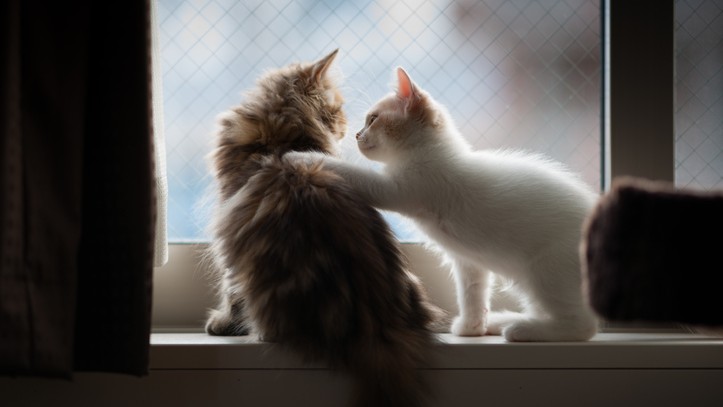How to introduce a kitten to a cat, according to a vet
Welcoming a new kitty to your clutter? Learn how to introduce a kitten to a cat with a vet's four-step guide

If you're bringing a new kitty into your home, you might be questioning 'how to introduce a kitten to a cat'?
Of course, welcoming a four-legged friend into your four walls is a very exciting time. You might have already stocked up on the best kitten toys to help stimulate their senses or the best kitten food to keep them well-fed. But if you're already the proud pet parent of another cat, all that fussing and excitement can quickly fade when you begin to think about how to introduce your latest recruit to your current cat (and their kingdom).
Firstly, know this: introducing a new kitten to your cat may be a smooth and easy process. Or, depending on your adult cat's personality, it could be a long, slow and frustrating time. But if there are any words of wisdom to live by, it's that slow and steady wins the race.
"Introducing the two cats gradually and intentionally can maximize the likelihood that the two cats get along with each other and enjoy (or at least tolerate!) each other’s company, enjoying a peaceful existence for years to come, " veterinary expert Catherine Barnette DVM tells us. And we couldn't agree more. As is the case when it comes to learning how to litter train a kitten, perfection takes time. But just think, once you've mastered the basics it will be so worth it in the long run!
To discover how to encourage your newest arrival and current cat to live in harmony, we racked Dr Barnette's brains to find out all her need-to-know advice.
A vet's guide on how to introduce a kitten to a cat

Animal lover and expert Dr Barnette graduated from the University of Florida, where she received both her B.S. in Zoology and her Doctor of Veterinary Medicine (DVM). In total, Dr Barnette has more than 15 years of clinical experience as a small animal veterinarian, looking after dogs, cats, and occasional exotic patients. In more recent times, Dr Barnette brings her decades of knowledge to a wider community, working as a freelance veterinary writer, and publishing expert-led content for fellow vets and pet parents. Dr Barnette lives with her husband and daughter (plus two cats, a dog, and a rescued dove!) in Florida.
1. Prepare for your home for your new addition
One way to work out how to introduce a new kitten before it happens is to set up a separate living area to house your kitten for the first several days or weeks. This might be a guest bedroom, a spare bathroom, the laundry room, or any other room that your current cat does not need to regularly access. In your kitten’s designated area, be sure to have the best kitten food and water bowls, a comfy bed, and the best kitten toys. Setting up a separate area for your kitten can minimize 'turf wars' between your cats, giving them time to adjust to each other’s presence without competing for the same space.
While you probably won’t need to keep the cats separated long term, the items you buy for your new kitten may be used for a while. Having separate litter boxes, feeding stations, and resting areas for each cat, even once they are successfully spending time together, can decrease competition and increase the likelihood that your cats will get along with each other. Keep this in mind when purchasing items for your kitten’s temporary lodging and deciding how to introduce a new kitten to your home.
Get the best advice, tips and top tech for your beloved Pets
2. Allow them to become familiar with each other’s scents
When you first bring home your new kitten, set her up in her room. This will allow her to become familiar with the location of the litter box and orient herself to her new environment. In most cases, your adult cat will soon notice the presence of a new kitten within the home, and the two cats will begin to smell each other and interact under the door. This allows the cats to become familiar with each other’s scent with minimal risk of injury.
After a day or two, begin periodically confining your adult cat to a small area while allowing your kitten out for brief forays into the rest of the house. Through this process, your kitten will become familiar with the layout of your house and the smell of your adult cat. When you return your kitten to her room and allow your adult cat out of confinement, your adult cat will be able to smell your kitten’s scent throughout the home, making the process of how to introduce a new kitten to your home easier.
Cats interact with the world largely through their sense of scent. So much so, that one article published in the Laboratory of Animal Medicine found that 'affiliative behaviors' in cats (i.e those that lead to the formation of social and emotional bonds or the desire to create such bonds) are those that facilitate proximity or contact.
So, allowing the two cats to become familiar with each other’s scent will increase the likelihood of a successful outcome when the two cats are allowed to interact directly, and giving you more knowledge of how to introduce a new kitten.

3. Let them meet 'in-person', under careful supervision
Once your cats have had several days to become familiar with each other’s scents and are interacting under the door without signs of aggression, you are ready to introduce them to each other face-to-face. Consider doing this at a time when your cats are slightly distracted, such as at mealtime. This can help alleviate tension by diffusing your cat’s attention so that they aren’t directly focused on each other.
There may be a little bit of hissing and growling as your two cats get to know each other. When this happens, try to distract or redirect your cats with a toy, treats, or food. Distracting the kitten can help give your adult cat a bit of peace and quiet, while distracting your adult cat can help minimize aggressive behavior. In case a fight does break out, keep a blanket or thick towel handy. This can be used to separate the fighting cats, while minimizing the risk of you becoming injured.
4. Encourage positive interactions between your cats
In the first several days or weeks (depending on how well your adult cat takes to your new kitten), your cats should only be allowed to interact under direct supervision. Your goal during this time is to encourage positive interactions. Consider feeding your cats meals together, petting your cats when they are in the same area, and otherwise making efforts to help your adult cat associate the kitten’s presence with positive outcomes. If at any point the two cats begin to fight, separate them for a brief period of time. This gives each cat a chance to 'cool off' after a negative interaction, minimizing escalation.
Even as you give your adult cat and kitten more time together, ensure that they also have time apart from each other. Provide each cat with separate litter boxes, food bowls and water bowls, and sleeping areas to minimize competition. If you have an especially playful kitten, you may want to consider using a baby gate or other barrier to create an area where your adult cat can escape for some peace and quiet when needed.
How long does it take for a cat to get used to a new kitten?
Your cat’s adjustment period may take some time. This is normal! While some cats will accept a new kitten within a matter of days, or even hours, it’s not uncommon for it to take several weeks or even months for a cat to acclimate to the presence of a new kitten in their home.
Keep in mind, also, that 'getting used to' the new kitten is not the same as becoming friendly with the new kitten! While your cat may learn to tolerate the new kitten after just a few weeks or months, showing less evidence of stress or signs of aggression directed toward the kitten, it may take a year or more before your adult cat begins to show signs of what you might consider 'friendship'. Depending on your adult cat, it’s actually possible they will never actually be friendly or loving towards the new kitten. As long as they coexist peacefully, though, you can consider their introduction a success.
What to do if your cat doesn't accept the new kitten
If you invest all of the necessary effort into gradual introductions and your cat still will not accept the new kitten, restart the process. Re-introduce your two cats in a more gradual manner. Separate the cats and go through the steps outlined above. Double or triple the amount of time you spend on each step, giving your cat plenty of opportunities to acclimate gradually.
When gradual introductions don’t work, it’s time to talk to your veterinarian. Your veterinarian can help you understand where things are breaking down in the relationship between your cat and your kitten. Depending on your situation, your veterinarian may recommend an over-the-counter product, such as Feliway, or a prescription medication to alleviate feline stress.
In some cases, despite your best intentions and ongoing efforts, two cats may struggle to get along. If this occurs, you may have some difficult decisions to make. While many owners assume they will need to give up one of their cats, instead consider whether there’s a way to give your cats two separate living spaces or otherwise accommodate the needs of both cats. By placing your cats in separate rooms or using an outdoor “catio” attached to your home, you may be able to find a way to meet the needs of both cats.
Remember: you never get a second chance to make a first impression
When considering how to introduce a new kitten to your older cat, remember that first impressions matter!
Making introductions thoughtfully and carefully can create positive associations between your adult cat and the kitten, while a hasty introduction may not go as smoothly.
Like humans, cats also appear to place a lot of weight on first impressions. If the first interaction between your cats is stressful, with lots of hissing and fighting, this may end up being a difficult setback from which to recover. Investing a little bit of time and effort up front can offer significant benefits over the rest of your cats’ lives together.
For more tips and tricks to help give your little feline friend the best start in life, be sure to check out our guide to when can kittens eat dry food?
Dr. Barnette is a graduate of the University of Florida, where she received both her B.S. in Zoology and her Doctor of Veterinary Medicine (DVM). She has 15 years of clinical experience as a small animal veterinarian, treating dogs, cats, and occasional exotic patients. She now works as a freelance veterinary writer, creating educational content for veterinarians, veterinary team members, and dedicated pet owners. Dr. Barnette lives in southwest Florida with her husband and daughter (plus two cats, a dog, and a rescued dove!) and enjoys kayaking, biking, and hiking. Learn more about Dr. Barnette at www.linkedin.com/in/catherinebarnette.
- Becks ShepherdFreelance Journalist

